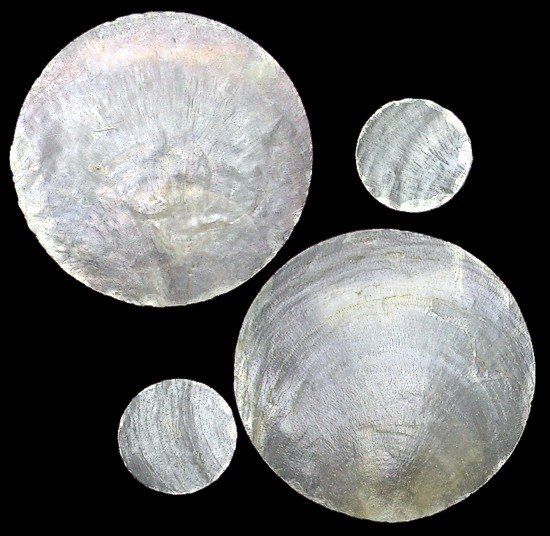One Round Capiz Shell measuring 1 inch in diameter, without a hole*******
One Round Capiz Shells, measuring 1 inch in diameter, without a hole
Orders usually process within 2 to 5 business days.
Email us at ja1@mindspring.com Make Your Selections and Shipping Preference. We Will Email You the amount of the Shipping Cost. When you receive the shipping cost go back into Shells of Aquarius and click into Purchase Shipping Label. There you will find UPS or USPS. Click into the option you decided on and make your payment. Your order will ship when shipping payment is received.
Placuna placenta common name Capiz Shell & windowpane oyster
Placuna placenta is a bivalve marine mollusk in the family of Placunidae. They are edible, but valued more for their shells (and the rather small pearls). The shells have been used for thousands of years as a glass substitute because of their durability and translucence. More recently, they have been used in the manufacture of decorative items such as chandeliers and lampshades; in this use, the shell is known as capiz shell (kapis). Capiz shells are also used as raw materials for glue, chalk and varnish.
(REF: "Placuna placenta (Linnaeus, 1758)". www.gbif.org.) (REF: "Fisheries and aquaculture of window-pane shells". Malacological Society of London)
Placuna placenta shells are found from the shallows of the Gulf of Aden to around the Philippines, where they abundant in the eponymous province of Capiz. The mollusks are found in muddy or sandy shores, in bays, coves and lagoons to a depth of about 330 feet.
These species have been in decline because of destructive methods of fishing and gathering such as trawling, dredging, blast fishing and surface-supplied diving. In the Philippines, fisheries are now regulated through permits, quotas, size limits and protected habitats. In spite of this, resources continue to be depleted.
(REF: Park, Monica. "Capiz Shells and Their Uses"
The nearly flat shells of the capiz can grow up to 6 inches in diameter, they reach maturity between 3 and 4 inches. The shell is secured by a V-shaped ligament. Males and females are distinguished by the color of the gonads. Fertilization is external and larvae are free-swimming like plankton for 14 days or attached to surfaces via byssal thread during metamorphosis, eventually settling on the bottom. They consume plankton filtered from the water passing through their slightly opened shell; the shell closes if the bivalve is above water during low tide.
A byssus is a bundle of filaments secreted by many species of bivalve mollusc that function to attach the mollusc to a solid surface. Species from several families of clams have a byssus, including pen shells (Pinnidae), true mussels (Mytilidae), and Dreissenidae.
(REF: Fisheries and aquaculture of window-pane shells". Malacological Society of London)
Aside from being abundant in the province of Capiz, capiz shells are also abundant in the island of Samal in the Philippines, where 500 tons of capiz shells are harvested every other year.
The capiz shells are found around the island, harvested and transformed into various decorative products. As late as 2005, the residents of the island were trained to sustain the industry. However, the transfer of institutional knowledge to new generations to maintain the industry is in danger of being lost.
(REF: Gonzaga, Robert (31 May 2012). "After Jessica Sanchez, Samal's capiz products now in limelight")
